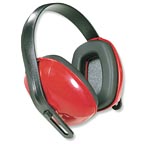
In 1996, NIOSH's National Occupational Research Agenda identified hearing loss as the most common job-related disease in the United States. Previous NIOSH health and safety investigative data of the mining industry indicate that at least 70 percent of mine workers, including those engaged in drilling activities, suffer noise-induced hearing loss severe enough to be classified as hearing disability.
A recent NIOSH investigation was conducted on four different air-rotary drill rigs with cabs to determine the noise exposure of the operators. Sound level measurements were recorded around the rig and on the operator in the cab during production drilling. The results of these measurements indicate that, in all cases, the drill rig generates hazardous noise levels. The noise exposure for the operators varied from rig to rig and was dependent on rig/cab design and the operator's work behavior. Acknowledging these hazardous noise conditions and taking precautions can protect drill operators from suffering from noise-induced hearing loss (NIHL).
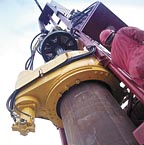
Sound Levels/Noise Exposures
Hearing loss can be caused from a variety of circumstances, including aging, disease, certain medications, injuries and accidents. Exposure to loud noise also can cause permanent and irreversible hearing loss, which often is painless and occurs over a long period of time. Medical technology cannot repair or reverse hearing loss damage caused by overexposure to noise. The Occupational Safety and Health Administration (OSHA) creates and enforces standards for most of the employees in the United States, excluding some occupations such as mining. Those working in the mining industry are regulated by the Mine Safety and Health Administration (MSHA). While according to OSHA and MSHA it is the responsibility of the employer to protect a worker's hearing, job-related hearing loss can be best prevented with assistance from the exposed worker. In order to protect hearing, both workers and their employers should understand how exposure to certain sound levels could damage hearing.Noise can loosely be defined as any unwanted sound. Sound results from a disturbance that causes small pressure fluctuations in the air. These pressure fluctuations can be barely audible or uncomfortably loud. Since the range of audible pressure fluctuations is so large, sound typically is measured in decibels (dB) or A-weighted decibels (dB(A)). The threshold of human hearing is 0 dB, which is barely audible even in the quietest environment. Sound levels of 120 dB are very loud and, in fact, actually can be felt physically in the ears. Some examples of sound levels associated with their sources are shown in Table 1 below.
Current NIOSH research is continuing to examine how occupational noise exposure damages human hearing. Both the sound level and duration of exposure are factors in hearing loss. The recommended exposure limit is 85 dB(A) for an average eight-hour work shift. NIOSH considers any exposure at or above this level to be hazardous, creating an excess risk of developing occupational NIHL.
It should be noted that in many working environments the sound levels are not constant, but rather fluctuate throughout an eight-hour shift. Since sound levels in most work areas fluctuate throughout the workday, the sound level must be continuously measured and averaged to determine an employee's accumulated dose percentage. Sound levels greatly exceeding the criterion level causes the accumulated dose percentage to rise rapidly; employees' exposure time to these high levels must be limited.
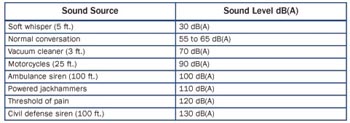
Rig and Site Characteristics
The A-weighted sound levels around four different air-rotary drill rigs with cabs operated by four different operators were investigated at production field sites. For quick reference and to avoid bias towards any one manufacturer or drill operator, the rigs will be referred to as Rig 1, Rig 2, Rig 3 or Rig 4. Of the four drill rigs, Rig 1 and Rig 2 were made by the same manufacturer, while Rig 3 and Rig 4 were made by different manufacturers. Rig 1 and Rig 2 were identical except Rig 1 was manufactured one year earlier than Rig 2. Table 2 outlines the general physical characteristics of each drill rig.
During the noise measurements, all of the rigs were drilling 51⁄2-inch to 67⁄8-inch blast holes at surface limestone mining operations. Drilling conditions were dependent on the structural integrity of the geology. In some cases, the strata were highly fractured due to inherent conditions or those induced by previous blasting. In other cases, the strata were competent or homogeneous. Hammer drilling was intermittent and time-consuming when the drilling strata were fractured. When the strata were competent, drilling usually was uninterrupted. In most cases, all of the drilling occurred on an overburden bench within 20 feet to 100 feet of a highwall.
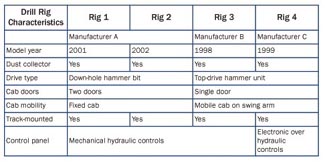
Sound Measurements
Two types of sound measurements were taken at each field site. One focused on the exterior sound generated by the drill rig during hammer drilling. The other focused on the operator noise exposure during the drilling cycles. Sound measurements around the rig were taken to identify how noise radiates out from the rig and what areas of the rig are the loudest. Average sound level measurements were recorded by the dosimeter worn by the drill operator to identify the overall noise exposure during several drilling cycles, and to identify how much influence one drilling cycle would have on his overall noise exposure for a typical workday.After the rig was in position and hammer drilling commenced, sound level measurements were taken at points on a grid system around the rig. The grid system, which included 20 microphone locations, was designed to record sound levels 360 degrees around the drill rig. The recorded sound levels then were plotted and contoured on a map to illustrate how noise radiated out and away from the rig during hammer drilling.
Average sound level measurements at the operator's position were taken with a noise dosimeter. A dosimeter measures sound levels with a microphone positioned near the operator's ear. The microphone is connected to a small data-recording device worn on the operator's belt. The dosimeter continuously monitors, integrates and records fluctuating sound levels to automatically calculate the accumulated dose and the Time-Weighted Average (TWA) sound level. Table 3 shows a sample correlation of varying TWAs to accumulated dose percentages, allowable exposure times, and accumulated dose percentages for an eight-hour shift.
Most workers are exposed to different sound levels during a working shift. Sometimes the sound levels are below 90 dB(A) and sometimes they are above 90 dB(A). For health (hearing loss) and compliance concerns, accumulated dose should not exceed 100 percent in any given day no matter how long the workday lasts (1, 4, 8, 10, 12 hours).
Previous NIOSH field investigations identified the drilling activity as the loudest activity during a normal work shift. Therefore, for this particular study, the focus is on the TWA and the accumulated dose the operator receives during the drilling of one hole. Based on the values from one hole, accumulated dose percentage projections can then be made for additional holes drilled in an eight-hour shift.
A time-activity study also was conducted concurrently with the dosimeter measurements. The time-activity study was recorded with a Personal Digital Assistant (PDA) synchronized with the dosimeter. Fourteen different job activities were programmed into the PDA, as follows:
1) Tramming
2) Hole breakdown
3) Hammering
4) Adding drill rod
5) Operator 25-plus feet away from rig
6) Operator within 25 feet of rig
7) Operator outside cab next to drill hole
8) Setting up
9) Drilling
10) Flushing the hole
11) Inside door open
12) Outside door open
13) Rig non-drilling, low idle
14) Removing drill rod
The duration of each activity was documented by a start and end time on the PDA. Synchronization of the PDA and dosimeter allowed for analysis of the sound levels associated with each drilling activity. This also allowed for cumulative noise analysis of each job activity for the duration of the field measurements.
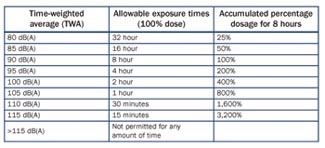
Rig 1 Measurements
The sound level measurements around Rig 1 during hammer drilling are from 91 dB(A) up to 107 dB(A). Sound level measurements recorded by the two microphones nearest to the cab were 107 dB(A) and 97 dB(A). For the most part, the area near the hole is the largest area of sound levels above 95 dB(A). In fact, all of the sound level measurements up to 50 feet away from the drill hole were above 90 dB(A) levels.
Dose measurements on the Rig 1 operator were recorded for eight hours and 27 minutes. As mentioned earlier, the focus of this study is to identify the TWA and accumulated dose percentage for the time period required to complete one hole in order to identify the particular drilling activities that result in the highest dose accumulation. The sound level exposure for this operator was above 90 dB(A) during most of the 33 minutes required to complete this hole. The only time the operator was not exposed to noise levels above 90 dB(A) was when he walked more than 25 feet away from the rig to a work truck while the rig was still drilling. The highest sound levels occurred when the operator had to open the cab door next to the hole during drilling because visibility was restricted. The sound levels reached 115 dB(A) during the periods with the door open.
Rig 2 Measurements
Rigs 1 and 2 are the same model, have the same equipment characteristics, and were manufactured by the same company one year apart. Therefore, the sound level characteristics of Rig 2 should be essentially the same as Rig 1.
Dose measurements for the operator of Rig 2 were recorded for eight hours and 58 minutes. The sound levels were consistently at 90 dB(A) during the approximate 21 minutes it took to complete this hole. Sound levels were above 90 dB(A) except at the start of drilling, when a drill rod was added, and when the hole was broken down. The only times the sound level went above 95 dB(A) were when the operator first started drilling with the door open and again when the operator opened the door next to the hole during the drilling with the second drill rod.
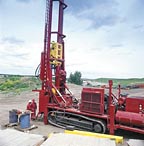
Rig 3 Measurements
As with Rigs 1 and 2, the sound levels on Rig 3 are well above 95 dB(A) all around the drill rig. The sound levels at the two microphones closest to the cab are 106 and 100 dB(A). In contrast to the results for Rigs 1 and 2, the sound levels appear to drop below 90 dB(A) at the microphone 50 feet (16 meters) away from the hole.
Dose measurements for the operator of Rig 3 were recorded for seven hours and two minutes. This operator was exposed to sound levels that typically were between 85 dB(A) and 90 dB(A) for the 46 minutes required to complete this hole. While the operator was adding drill rods, the sound level dipped below 85 dB(A).
Rig 4 Measurements
Unlike Rigs 1, 2 and 3, Rig 4 is not completely surrounded by sound levels above 95 dB(A). All of the area around the cab and the hole is dominated by sound levels between 90 and 95 dB(A). Additionally, sound levels below 90 dB(A) are observed within 13 feet (4 meters) from the hole. Based on these measurements, Rig 4 appears to be much quieter around the cab and the hole during hammer drilling. However, based on preliminary sound level tests, dosimeter measurements and first-hand field observations, these measurements may not necessarily represent the actual sound level profile generated by Rig 4 when it is hammer drilling. It is possible that the measurements taken during this test were recorded during a period when the rig was drilling but not hammering, or hammering intermittently, because of fractured strata.
Dose measurements on the Rig 4 operator were recorded for eight hours and 26 minutes. The sound levels consistently were between 80 dB(A) and 85 dB(A) for the approximately 48 minutes needed to complete this hole. The only variations in the sound levels were while the operator was adding drill rods, setting up the hole and breaking down the hole.
ND
Report Abusive Comment